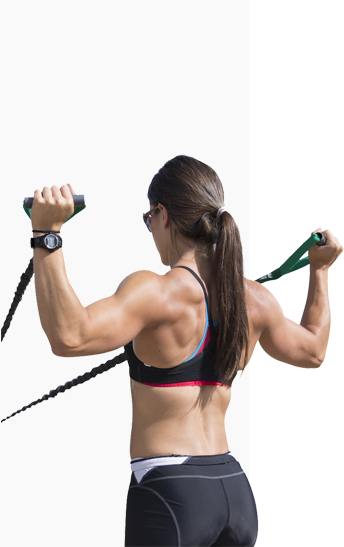How to Progress to a Pain-Free Overhead Press

If you’ve been dodging this move because of shoulder pain, it may be time to face your fears!
The overhead press is a sticking point for many when it comes to shoulder pain, but it can also be part of the solution because a strong shoulder is a pain-free shoulder!
The following guide will get you pressing pain-free and on your way to overhead strength gains.
The Press Fix
Progressing through pain-free movement is an essential part of a recovery plan. When using this plan, pain should never be more than a 3 on a scale to 10 and should return back to baseline within 2 hours of training, and there should be no additional discomfort the following day.
If you can’t seem to make this happen, some extended time off while working improving your shoulders is recommended. Our 30-Day Shoulder Fix would be the perfect solution.
But here are some additional steps you can start today to get the press back into your training plan.
Warm-Up Better
Sometimes a quality warm-up is enough to solve the restrictions stopping the press. This is also the corrective approach to improve shoulder position for pain-free shoulder movement.
- Start with 5 minutes of soft tissue work (foam rolling, etc.) with a special focus on the thoracic spine and lats.
- Active Stretches- Get the body moving through ranges of motion needed for the press.
- Crossover Symmetry Activation– This alone will help your mobility more than anything. Getting muscles firing at the end range will signal the body that it’s OK to work this new ROM. The simple progression of the Crossover Symmetry program flips on the switches for the pieces needed to go overhead. So if you’re not using Crossover Symmetry pre-workout, it’s time to get on it!
Progressions
In addition to the previous warm-up, getting to a rockstar overhead press means doing some pressing. But don’t just hammer a square peg into a round hole.
Use the following training progression to meet your shoulders where they are at. Then build into the full range barbell movement as your shoulders allow.
- Standing Landmine Press
- Single Arm Dumbbell Press
- 2 Arm Dumbbell Press
- Barbell Press
- Push Press
You should have limited pain through the full range of motion and feel strong at the end range. If you don’t, then move down the progression and stay there for as many workout sessions necessary.
Pro Tips For Pressing with Pain
Many shoulders will have great success starting from square one and then progressing over time along with a more specific shoulder strengthening program like Crossover Symmetry.
Here are some additional tips to get you around certain sticking points.
1. Press in the Plane of Scaption
If you watched the exercise technique videos above, we talked a bit about the plane of scaption. This describes the natural plane that the scapula sits. In this position, less strain is placed on the cuff tendons and shoulder ligaments.
He doesn’t talk about scaption, but here’s an Instagram post by Jared Enderton talking about driving the elbows wide in the pressing position, this essentially puts you in the correct position.
2. Painful Eccentric
Many will be able to press upwards (called the concentric), but find issues when lowering the barbell (during the eccentric.)
A set of jerk blocks is a great way to get around this.
With blocks, you can work on the pressing portion with a heavier load and simply drop to the blocks between reps. Since blocks aren’t readily available in the gym, you can also do this with bumper plates, but you will have to clean the weight back to the shoulder and make sure your gym is cool with dropping weights overhead.
Or a final option is to let the bar drop to the shoulders rather than lowering it. Here is another technique video from Jared on reracking.
3. Scale Up on the Movement
It makes sense that going lighter would be helpful. Although, if you just opt to go light, you may not get much from your workout.
One of the things we talk about in our Shoulder Scaling Guide is scaling up on a movement during a workout. That means looking for ways to make the exercise harder so you can get more while going a bit lighter.
The easiest way to do this is to slow down the rep.
Rather than banging out your reps, focus on a full 2-second lift, pause at the top, and then a full 2 second lower. This increased time under tension will improve the training effect while using lighter loads.
4. Fall in Love with Isometrics
We wrote about adding isometric to your program a few weeks ago. For the shoulder, overhead carries can add some training load to your shoulders, without having to grind through the press portion of the movement.
You may have to get creative in getting overhead with the weight, but once you’re there, you are good to go.
Meeting Your Goals
If pushing weight overhead is important to you, but you’ve been stopped by pain, then hopefully this guide is helpful to achieve your goals.
Although it’s important to understand your need to press overhead. If you’re doing it for strong shoulders, note that there are movements less provocative for pain, such as the landmine press or single arm dumbbell press, that still train the shoulders effectively.
But if getting overhead with a barbell is on your list of things that bring life satisfaction— it may part of your job, you want to follow a training program like CrossFit, or you might just love the movement— take some time and build it up.
It won’t be perfect tomorrow, but over time (could be months), you’ll gradually build your capacity to get overhead without pain.








